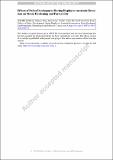Effects of Defect Development During Displacive Austenite Reversion on Strain Hardening and Formability
Author(s)
Jiang, Menglei; Kang, Jiyun; Hirst, Charles Arthur; Taşan, Cemal Cem
Download11661_2020_5835_ReferencePDF.pdf (1.557Mb)
Open Access Policy
Open Access Policy
Creative Commons Attribution-Noncommercial-Share Alike
Terms of use
Metadata
Show full item recordAbstract
Martensite that is mechanically induced from metastable austenite can be reversed to austenite upon annealing. The reversion transformation can be either diffusive or displacive, and the defect substructure development, in either case, has mechanical consequences. Here, to better understand the effects of microstructure development during displacive phase transformations, we focus on the influence of the initial plastic deformation on the austenite reversion (α′ → γ) in a transformation-induced plasticity-maraging steel. The phase transformation kinetics and the developing defect structure within the reversed γ phase are characterized by carrying out differential scanning calorimetry measurements, electron-backscattered diffraction, and electron channeling contrast imaging analyses. The resulting mechanical behavior is investigated by uniaxial and biaxial tension experiments. These investigations demonstrate that the defect development during sequential deformation-annealing treatments can help increase the overall strain hardening capacity of the alloy, which in turn increases the accumulative uniform elongation, and the formability. While the necking can be progressively delayed to higher strain levels following such treatments, the local fracture strain apparently cannot be, due to damage accumulation.
Date issued
2020-05Department
Massachusetts Institute of Technology. Department of Materials Science and Engineering; Massachusetts Institute of Technology. Laboratory for Nuclear ScienceJournal
Metallurgical and Materials Transactions A
Publisher
Springer Science and Business Media LLC
Citation
Jiang, Menglei et al. "Effects of Defect Development During Displacive Austenite Reversion on Strain Hardening and Formability." Metallurgical and Materials Transactions A 51, 8 (May 2020): 3832–3842 © 2020 The Minerals, Metals & Materials Society
Version: Author's final manuscript
ISSN
1073-5623
1543-1940